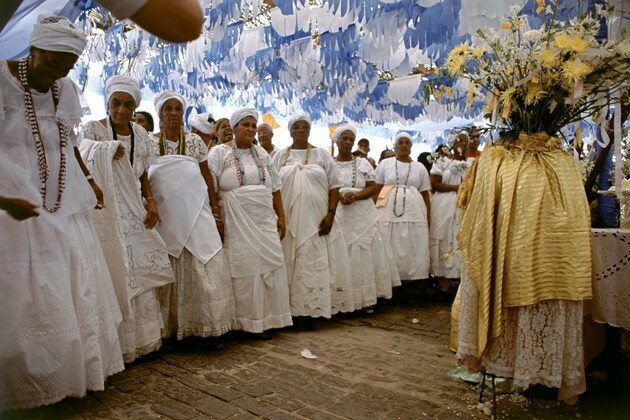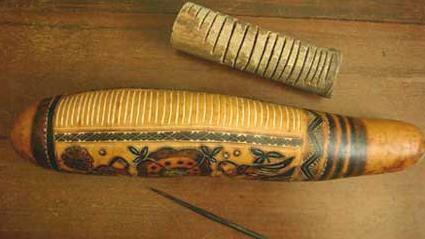Candomblé and Umbanda, despite their similarities, have many differences between them, such as origin, relationship with orixás, rituals, the phenomenon of incorporation, among others.
Candomblé came from Africa, brought to Brazil through enslaved black Africans. Here, it underwent adaptations and is considered an Afro-Brazilian religion.
Umbanda is a properly Brazilian religion and its foundations were revealed by Zélio Fernandino de Moraes. Umbanda is marked by strong syncretism between Catholicism, Spiritism and Afro-Brazilian religions.
| candomblé | umbanda | |
|---|---|---|
| Definition | Candomblé is an Afro-Brazilian religion, which was brought by enslaved Africans. | Umbanda is a Brazilian religion that mixes elements of Catholicism, Spiritism, and Afro-Brazilian religions. |
| Origin | African. | Brazilian. |
| Creation | At the end of the XVI century. | 1908. |
| Belief | Follow the laws of nature. Their deities are the orixás, who would have the role of caring for and balancing our energies. | It follows the laws of nature and the spiritual plane, in addition to the principles of fraternity and charity. |
| orixás | They see the orixás as divine ancestors, who are the gods of nature and representatives of a unique and creator god. | They see the orixás as ancestral spirits and the manifestation of the only god. |
| spirits | The spirits that manifest on earth are the Egun, souls who were initiated or not in this religion. | The spirits that appear during the works are from people who return to earth to practice charity. |
| Assistance | Made through consultation with búzios. | Made through the pass, a kind of blessing and spiritual cleansing. It occurs through conversation with spirits, which is done through an incorporated medium. |
| Incorporation | In the most orthodox candomblé, there is no practice of incorporation and mediumship. Entities only offer energy and communication is done through the whelks. | Made through mediums. |
| Exu | It is seen as an orixá, a guardian and messenger between the material and spiritual world. | Like all orixás, it is one more spirit that teaches human beings how to evolve. |
| animal slaughter | It takes place during the feasts of the orixás. | There is no slaughter of animals in the rituals. |
| structure of the yards | There are no altars. | There is an altar. |
| ditties | They use languages of African origin such as Yoruba or the kimbundu. | Sung in Portuguese, but may feature words in African languages. |
| Title of person leading the ritual | Men are called babalorixá or babalaô. As for women, ialorisha or ialaorisha. | The person who commands the center of Umbanda can be called Pai de Santo, Mãe de Santo, Pai de Terreiro, Mãe de Terreiro or Leader. |
| number of orixás | They can vary from 16 to 72 orixás, depending on the Candomblé house. | 9 orixás (Iansã, Iemanjá, Nana Buruquê, Obaluaê/Omulú, Ogun, Oxalá, Oxossi, Oxum and Xangô). |
candomblé

Candomblé is an African religion that arrived in Brazil along with the black people who came as slaves. The belief follows the laws of nature and its deities are the orixás, seen as divine ancestors who take care of and balance our energies.
Different from Umbanda, where the communication between the orixás and the land takes place through incorporation, in Candomblé it is done through the reading of buzios.
umbanda
Umbanda is a Brazilian religion that emerged in 1908 and was revealed by Zélio Fernandino de Moraes, born in São Gonçalo (RJ) and mixes elements of Catholicism, African cults and Kardecism.
The religion believes in the orishas as ancestral spirits, who communicate with the earth through the incorporation of mediums.
The works and assistance occur while the spirits are incorporated. During incorporation, some orixás/spirits make use of tobacco and drink by the mediums. Others, however, like the spirits of children, prefer sweets and toys.
On the other hand, animals are not slaughtered in offering and thanksgiving ceremonies.
And what is macumba?

Although the term is used erroneously by many people, macumba is the name of a tree and a percussion musical instrument used in Afro-Brazilian religions. Thus, macumbeiro is the individual who plays such an instrument.
In Brazil, the word "macumba" popularly and mistakenly designates any offering to the orixás. The correct term for this, in Candomblé, would be "ebó" or "padê". In Umbanda it would be "dispatch".
It can still refer to a specific religion of African origin.
See also the difference between:
- Protestants and Evangelicals
- Popular and scholarly culture
- creationism and evolutionism
- astronomy and astrology
- atheist and agnostic
- Being Catholic and being Christian


